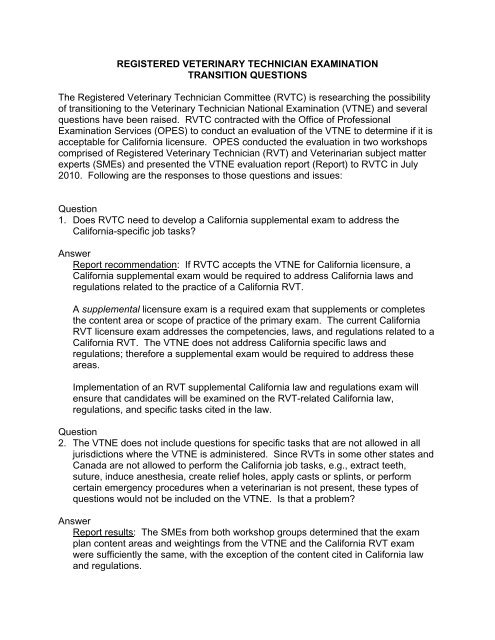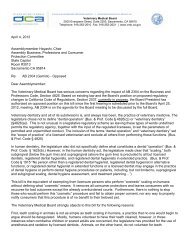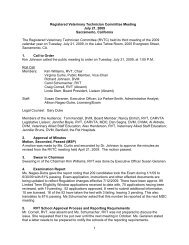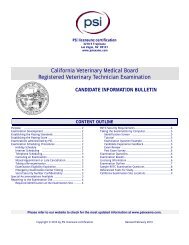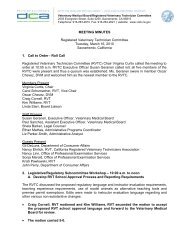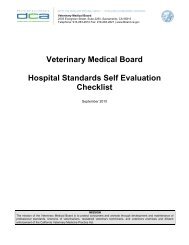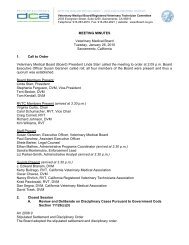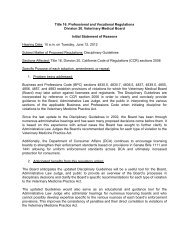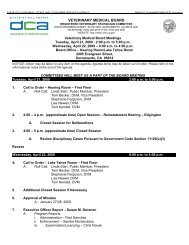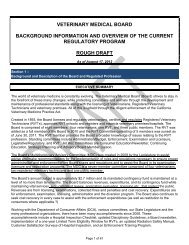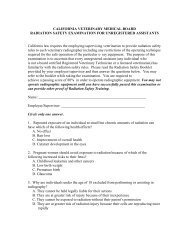registered veterinary technician examination transition questions
registered veterinary technician examination transition questions
registered veterinary technician examination transition questions
You also want an ePaper? Increase the reach of your titles
YUMPU automatically turns print PDFs into web optimized ePapers that Google loves.
REGISTERED VETERINARY TECHNICIAN EXAMINATIONTRANSITION QUESTIONSThe Registered Veterinary Technician Committee (RVTC) is researching the possibilityof <strong>transition</strong>ing to the Veterinary Technician National Examination (VTNE) and several<strong>questions</strong> have been raised. RVTC contracted with the Office of ProfessionalExamination Services (OPES) to conduct an evaluation of the VTNE to determine if it isacceptable for California licensure. OPES conducted the evaluation in two workshopscomprised of Registered Veterinary Technician (RVT) and Veterinarian subject matterexperts (SMEs) and presented the VTNE evaluation report (Report) to RVTC in July2010. Following are the responses to those <strong>questions</strong> and issues:Question1. Does RVTC need to develop a California supplemental exam to address theCalifornia-specific job tasks?AnswerReport recommendation: If RVTC accepts the VTNE for California licensure, aCalifornia supplemental exam would be required to address California laws andregulations related to the practice of a California RVT.A supplemental licensure exam is a required exam that supplements or completesthe content area or scope of practice of the primary exam. The current CaliforniaRVT licensure exam addresses the competencies, laws, and regulations related to aCalifornia RVT. The VTNE does not address California specific laws andregulations; therefore a supplemental exam would be required to address theseareas.Implementation of an RVT supplemental California law and regulations exam willensure that candidates will be examined on the RVT-related California law,regulations, and specific tasks cited in the law.Question2. The VTNE does not include <strong>questions</strong> for specific tasks that are not allowed in alljurisdictions where the VTNE is administered. Since RVTs in some other states andCanada are not allowed to perform the California job tasks, e.g., extract teeth,suture, induce anesthesia, create relief holes, apply casts or splints, or performcertain emergency procedures when a veterinarian is not present, these types of<strong>questions</strong> would not be included on the VTNE. Is that a problem?AnswerReport results: The SMEs from both workshop groups determined that the examplan content areas and weightings from the VTNE and the California RVT examwere sufficiently the same, with the exception of the content cited in California lawand regulations.
Implementation of an RVT supplemental California law and regulations exam willensure that candidates will be examined on the RVT-related California law,regulations, and specific tasks cited in the law. For example, four out of five tasksmentioned in the question above are cited in the California Business andProfessions (B&P) Code, which would be included in the supplemental California lawand regulations exam. As stated in B&P Code section 2036:(b) An R.V.T. may perform the following procedures only under the directsupervision of a licensed veterinarian and when done so pursuant to thedirect order, control and full professional responsibility of the licensedveterinarian:(1) Anesthesia induction by inhalation or intravenous injection;(2) Application of casts and splints;(3) Dental extraction;(4) Suturing of existing skin incisions.Question3. If needed, who would create and administer the California supplement? If it doesinclude the RVT job tasks, do we (California) create the exam ourselves? Thiswould require item writing, reviewing, and Angoff workshops, workshops to put theexam together, as well as periodic practice analysis, which would cost almost or justas much as creating the entire exam we do now. If the purpose of <strong>transition</strong>ing tothe VTNE is to save money, having to do workshops removes that justification. And,if the supplement is administered on computer, will it be at the same sites and timeas the VTNE, or will candidates have to go to two different sites at two differenttimes? Certainly, having to take two exams, especially if they are given at differenttimes and locations, will increase the cost, inconvenience and anxiety for Californiacandidates.AnswerRVTC may contract with OPES to develop the supplemental California law andregulations exam. Best practice for an exam development cycle includes thedevelopment of an exam plan, item writing, item review, exam construction andsetting the passing score. Even though this cycle is the same as the current examdevelopment cycle, there are significant cost savings in developing a supplementalexam plan instead of a competency occupational analysis and by combining theexam construction workshop with the passing score workshop if the number of itemson a test is 100 or less.The VTNE is administered by Prometric at testing centers throughout the US andCanada as a computer-based exam given in three testing windows each year. Thecurrent RVT exam is administered by PSI at 13 testing centers throughout California,also as a computer-based exam. The supplemental California law and regulationsexam could be administered at the same California PSI testing centers and RVTCcould contract with PSI for additional ten nationwide testing centers at no cost.
Several boards within DCA have licensure candidates who take a national exam anda supplemental California exam at different test centers.Question4. Since Canada does not use the English math system anymore, are there no<strong>questions</strong> on the VTNE regarding conversions from the English system to metric,and if not, is that a problem?AnswerNo, it should not be a problem. One of the goals during both the workshops was todetermine if the VTNE exam covered the same content as the California RVT<strong>examination</strong>.Report results: For this purpose, the SMEs were given the California RVT examplan and asked to link each California task to a VTNE exam plan task andknowledge that covered the same content. The SMEs from both workshops wereable to link each California task to a task and knowledge on the VTNE exam planwith the exception of those pertaining to California law and regulations. Californiatasks related to math were included in this linkage.It is a candidate’s responsibility to have sufficient knowledge of all tasks andknowledge cited in the exam plan at the minimum acceptable competence level.Question5. One of the determinations made by the SMEs during the two validation workshopswas that, in addition to the VTNE, California should require a law and jurisprudenceexam. It was not made clear whether this would be a take-home exam like it is forveterinarians, or given on computer.AnswerReport recommendation: If RVTC accepts the VTNE for California licensure, aCalifornia supplemental exam would be required to address the California laws andregulations related to the practice of a California RVT.The intent of the recommendation to implement a supplemental exam was todevelop a licensure exam. This licensure exam is intended to be a secure examwith pass/fail consequences to licensure. The SMEs expected any implementationof a supplemental exam to be treated the same as the current California RVT exam,being of a secure type and administered by computer. The SMEs wanted evidenceof candidate proficiency in California law, regulations, and specific tasks cited in thelaw. A take-home exam would be considered an education tool, not a licensureexam. Therefore, based on the evaluation results, OPES cannot endorseimplementing a take-home or educational exam.
Question6. There were some concerns about whether the law exam, if it contained <strong>questions</strong>about the RVT job tasks, could be a take-home exam.AnswerSee the response to question #5. The intent of the recommendation from theevaluation was to implement a secure and computer-based licensure exam withlicensure consequences. A take-home exam would be considered an educationaltool which was not the intent of the SMEs.Question7. If the California supplement is only jurisprudence, how do we justify stating thatRVTs in California have been trained and tested in the RVT restricted tasks if theyare not included on the exam? How would we know if an RVT is really minimallycompetent to induce anesthesia, suture, etc., if they are not tested in these areas?How would we justify stating that an RVT is different from an un<strong>registered</strong> assistantif we have no test <strong>questions</strong> on the tasks that only RVTs may perform? And howcan OPES state the VTNE is sufficient (except for jurisprudence) if it does notinclude the most important, high-risk job tasks RVTs perform?AnswerTaking a licensure exam provides an assessment of a candidate’s overall level ofknowledge related to specified content areas. To pass a licensure exam, acandidate must get a total number of <strong>questions</strong> correct across content areas thatwould represent the minimally acceptable competence (MAC) level, determined bySMEs. Passing an exam is not proof that the candidate has sufficient knowledge oneach and every topic, but evidence that the candidate has sufficient overallknowledge equal to the MAC.Each form of an exam will not have a question on everything that a licensee islicensed to perform. Any given form of an exam is only a sampling of <strong>questions</strong>selected to meet the percentage or weight requirements of the current exam plan.Therefore, on any exam form, some task/knowledge may not be tested.If a supplemental California law and regulations exam is implemented, the examplan will be developed by SMEs selecting RVT-related California law, regulations,and specific tasks cited in the law.If RVTC wants to ensure that each candidate has the skill and ability, above theknowledge, to perform identified tasks, then a practical exam of each of these tasksshould be implemented.Finally, the differences between RVTs and un<strong>registered</strong> assistants are delineated bythe requirements for registration, e.g., education, eligibility, and licensingrequirements.
Question8. What input would California have on the committee in charge of the VTNE, since wewould be supplying the second largest group of candidates for the VTNE afterCanada? It appears that Canada has a dedicated seat on that committee.AnswerThe representatives on the VTNE committees are volunteers, so California could askfor persons to volunteer to sit on the committee, but appointments to the committeeare based on availability whether or not someone volunteers to participate, and theBoard has no control over a person’s desire to participate.Question9. In the past, OPES has stated that it is inappropriate for RVT educators, especiallyprogram directors, to participate in exam preparation. OPES will not even allowmembers of RVTC to participate in its workshops because they believe thatconstitutes some sort of conflict of interest. However, most of the people in chargeof the test preparation for the VTNE are RVT program directors or instructors. Ibelieve Dr. Hollingshead himself is an RVT educator, so why is that not a problem?AnswerOPES is finalizing its DCA policy regarding restrictions for Board and Committeemembers, educators, and instructors participating as SMEs in State licensure examdevelopment. OPES cannot enforce its policy on members of national committees.SummaryRVTC contracted with OPES to conduct an evaluation of the VTNE. The purpose ofthis evaluation was to determine if the VTNE would be acceptable as the RVTcompetency exam for California licensure. This evaluation was conducted by OPESwith two SME workshops on March 25-26, 2010, and April 29-30, 2010. The SMEsevaluated the VTNE to determine if it meets professional psychometric standards andcontent acceptable for California licensure.The evaluation results state the VTNE does meet professional psychometric standardsand content acceptable for California licensure with the exception of California-specificlaw and regulations.The SMEs from both workshops were unanimous in their recommendation that RVTCmay accept the VTNE for California licensure, only under the stipulation that asupplemental exam of RVT-related California law and regulation be administered toeach candidate for licensure. This supplemental exam would ensure that the Californiaspecifictasks cited in the law could be tested.It was the intent of the SMEs that the supplemental exam follow the same licensurecriteria and consequences (i.e. secure, computer-based, pass/fail results) as the current
California RVT exam. Therefore, the implementation of a take-home exam, whichwould be considered an educational tool instead of a test of knowledge, would not be incompliance with the recommendation from the evaluation.


